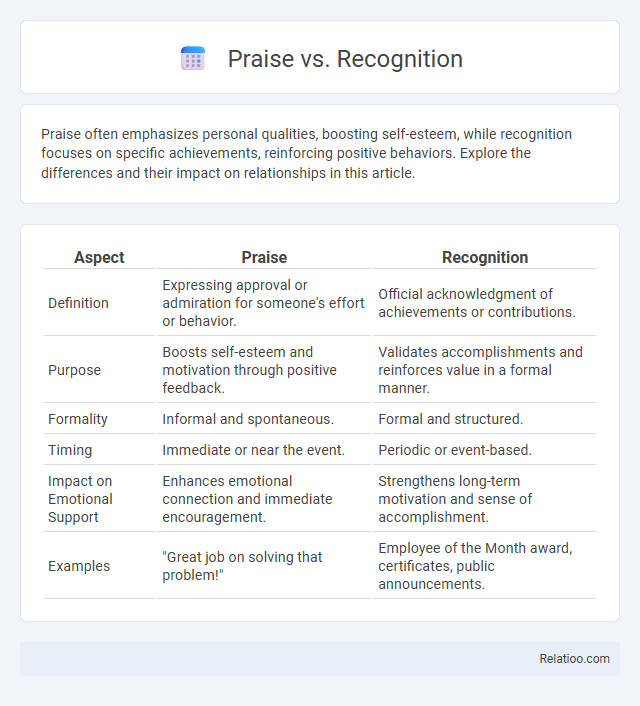Praise often emphasizes personal qualities, boosting self-esteem, while recognition focuses on specific achievements, reinforcing positive behaviors. Explore the differences and their impact on relationships in this article.
Table of Comparison
| Aspect | Praise | Recognition |
|---|---|---|
| Definition | Expressing approval or admiration for someone's effort or behavior. | Official acknowledgment of achievements or contributions. |
| Purpose | Boosts self-esteem and motivation through positive feedback. | Validates accomplishments and reinforces value in a formal manner. |
| Formality | Informal and spontaneous. | Formal and structured. |
| Timing | Immediate or near the event. | Periodic or event-based. |
| Impact on Emotional Support | Enhances emotional connection and immediate encouragement. | Strengthens long-term motivation and sense of accomplishment. |
| Examples | "Great job on solving that problem!" | Employee of the Month award, certificates, public announcements. |
Understanding Praise and Recognition
Praise involves expressing approval or admiration for specific actions or qualities, often emphasizing personal effort and achievements to motivate and reinforce positive behavior. Recognition encompasses formal or informal acknowledgment of an individual's contributions or accomplishments, typically within organizational or social contexts to boost morale and engagement. Understanding the difference between praise and recognition helps organizations tailor effective motivational strategies, ensuring praise targets individual effort while recognition highlights overall impact.
Key Differences Between Praise and Recognition
Praise focuses on highlighting specific actions or qualities, often given immediately to reinforce positive behavior, while recognition involves acknowledging broader achievements or contributions, usually in formal or public settings. Recognition tends to have a lasting impact by motivating continuous improvement and fostering a sense of value within a team or organization. Understanding the key differences between praise and recognition helps you effectively boost morale and enhance overall performance.
Psychological Impact of Praise and Recognition
Praise triggers dopamine release in the brain, enhancing motivation and reinforcing positive behavior by directly affirming individual achievements. Recognition, often more public and formal, strengthens social bonds and self-esteem by validating efforts within a community or organizational context. Both praise and recognition contribute to psychological well-being, but recognition typically fosters a deeper sense of belonging and long-term engagement.
Benefits of Recognition in the Workplace
Recognition in the workplace fosters employee motivation and engagement by validating individual contributions and boosting morale. Your team feels valued and empowered, leading to increased productivity and reduced turnover rates. Unlike generic praise, meaningful recognition creates a culture of appreciation that drives long-term performance and job satisfaction.
Common Misconceptions About Praise
Praise is often mistaken for recognition, but while praise highlights specific behaviors or achievements, recognition acknowledges overall contributions consistently. Common misconceptions about praise include believing it always motivates or that it must always be positive; your approach should balance genuine, specific feedback to effectively encourage growth. Understanding these distinctions helps you foster a more meaningful and empowering environment.
Best Practices for Delivering Effective Recognition
Effective recognition requires specificity, timely feedback, and alignment with individual or team values to maximize motivation and engagement. Using sincere praise that highlights concrete achievements fosters a culture of appreciation and reinforces desired behaviors. Best practices emphasize consistency, personalization, and public acknowledgment to enhance the impact of recognition programs.
Potential Pitfalls of Overusing Praise
Overusing praise can diminish its effectiveness by creating dependency on external validation, which undermines intrinsic motivation and potential growth. Unlike genuine recognition that acknowledges specific achievements, excessive praise may lead to inflated self-esteem and reduce resilience in the face of challenges. Your ability to balance praise with constructive feedback is crucial to fostering authentic development and long-term success.
Integrating Recognition Into Company Culture
Integrating recognition into company culture fosters employee engagement by consistently acknowledging achievements and contributions beyond simple praise. Recognition involves formal systems and ongoing practices that highlight individual and team successes, creating a motivating environment that praise alone may not sustain. Embedding these recognition frameworks into daily operations enhances morale, productivity, and organizational loyalty.
Measuring the Impact of Praise and Recognition
Measuring the impact of praise and recognition involves assessing tangible outcomes such as employee engagement, productivity, and retention rates. Praise often provides immediate motivation through positive verbal feedback, while formal recognition typically generates longer-term benefits by acknowledging achievements with awards or incentives. Data-driven approaches like employee surveys, performance metrics, and real-time feedback tools enable organizations to quantify how both practices contribute to workplace morale and overall success.
Choosing the Right Approach for Maximum Motivation
Recognition emphasizes acknowledging specific achievements, boosting employee morale through targeted appreciation, while praise generally offers positive feedback that reinforces desired behaviors. Choosing the right approach depends on individual preferences and organizational culture; recognition often drives long-term motivation by validating contributions, whereas praise fosters immediate enthusiasm and engagement. Combining both strategies strategically enhances performance by addressing diverse motivational needs and reinforcing continuous improvement.

Infographic: Praise vs Recognition
 relatioo.com
relatioo.com